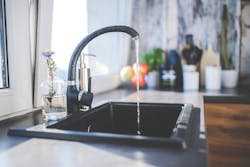Reducing the Q Criterion for Endpoint Devices in NSF/ANSI/CAN 61
About the author:
Kathryn Foster is technical operations manager of global water systems/municipal water products for NSF International. Foster can be reached at [email protected].
For decades, reducing lead exposure has been an ongoing goal for governments, communities and individuals. Reducing lead exposure from drinking water is especially critical for pregnant women, infants and children, who represent the population most sensitive to lead. Children’s developing nervous systems are more susceptible to damage from lead exposure, resulting in reduced IQ, learning disabilities, inattention, aggression and other behavioral problems. Public health officials from the U.S. Centers for Disease Control and Prevention, the World Health Organization and other organizations have concluded that there is no safe level of lead.
Given children’s particular sensitivity to lead poisoning, recent efforts have focused on reducing lead levels in schools and daycare centers. To help these facilities address and remediate lead in their drinking water, the U.S. EPA issued its 3Ts for Reducing Lead in Drinking Water in Schools and Child Care Facilities manual, which provides guidance on identifying potential problems with plumbing systems and materials that are contributing lead to the facilities’ drinking water.
This widely used manual recommends that action toward lead remediation be taken for any fixture fittings where the lead concentration exceeds 20 µg/L. However, in recent years, even this level has been determined to be insufficiently safe for children, and many local and state testing programs are setting trigger concentrations of 10 or 15 µg/L or even lower. Additionally, in 2016, the American Academy of Pediatrics issued a recommendation that state and local governments take steps to ensure that water supplies in schools do not exceed concentrations of 1 µg/L of lead.
Increase in End-Point Lead Protection Trends
NSF/ANSI/CAN 61: Drinking Water System Components-Health Effects is the widely accepted North American health effects standard for limiting leaching from products that come into contact with drinking water. End-point devices present in the last liter of the plumbing system, such as faucets, flexible plumbing connectors and supply stops are evaluated under Section 9 of this standard to a statistical criterion known as the Q statistic for lead leaching.
The Q is a statistical representation of the average dose of lead (in µg) which may leach from an endpoint device following overnight dwells during the first few weeks of product use. This statistic represents a 90% confidence level that 75% of all units from a product line would have a lead dosage of less than or equal to the Q value calculated. The current Q criterion is 5 µg for endpoint devices other than supply stops, flexible plumbing connectors and components, which must meet a Q criterion of 3 µg.
As a result of this trend toward lower and lower lead reduction goals, building administrators and other individuals in charge of lead remediation programs in schools and child care facilities recognized a need to identify lower-lead emitting faucets, even among those certified to the 2019 version of NSF/ANSI/CAN 61, which could have a Q value of up to 5 µg.
In recognition of this need, the Drinking Water Additives Joint Committee that oversees NSF/ANSI/CAN 61 spent significant effort in exploring ways to reduce lead leaching from end-point devices. Subcommittee task groups comprised of experts from industry, public health and user groups worked throughout 2018 and 2019 to discuss potential revisions to the standard that would allow consumers to identify lower lead-leaching devices in the marketplace.
2020 Updates to NSF/ANSI/CAN 61 Reduce Q Criterion
This work culminated in a ballot proposal for a standard revision that was ultimately approved by both the Joint Committee on Drinking Water Additives and the Council of Public Health Consultants and published in the 2020 edition of NSF/ANSI/CAN 61. The new standard requirements reduce the current Q criterion in NSF/ANSI/CAN 61 from 5 µg for faucets and other end-point devices and 3 µg for supply stops, flexible plumbing connectors and components to 1 µg and 0.5 µg, respectively.
Products will be evaluated to the new, more stringent criteria on an optional basis for a three-year period, at the request of the product manufacturer. Product manufacturers who opt to have their products evaluated to the new criteria will be required to indicate compliance to the new criteria with “NSF/ANSI/CAN 61: Q < 1” or “NSF/ANSI/CAN 61: Q < 0.5” on the product’s consumer-facing product packaging or labeling, as well as in the certification listing. This labeling requirement allows for easy identification of lower lead emitting products by the end user.
Effective Jan. 1, 2024, the reduced Q criteria will become mandatory for all faucets and other endpoint devices certified under NSF/ANSI/CAN 61. After this date, any products that do not comply with the 1 µg/0.5 µg Q criteria will no longer be eligible for certification under NSF/ANSI/CAN 61. This phased approach for implementation of the new criteria allows products that comply with the lower criteria to be easily identified by consumers as soon as they become certified and available in the marketplace, while allowing time for end-point device manufacturers to redesign and retest their products that may not currently meet the more stringent lead leaching criteria.
A key strength of the consensus standard system is that it allows for products to be evaluated to standards that are kept relevant through continual updates in response to updated science, evolving technology and evolving public health needs. This latest reduction to the lead extraction criterion for end-point devices in NSF/ANSI/CAN 61 illustrates how industry, public health officials, and local and state governments can work together in service of a common goal of eliminating lead from the water we all drink, and making it easier for schools and daycare centers to protect the health of infants and children.
About the Author
Kathryn Foster
Kathryn Foster is senior operations manager for Commercial Water, NSF.
